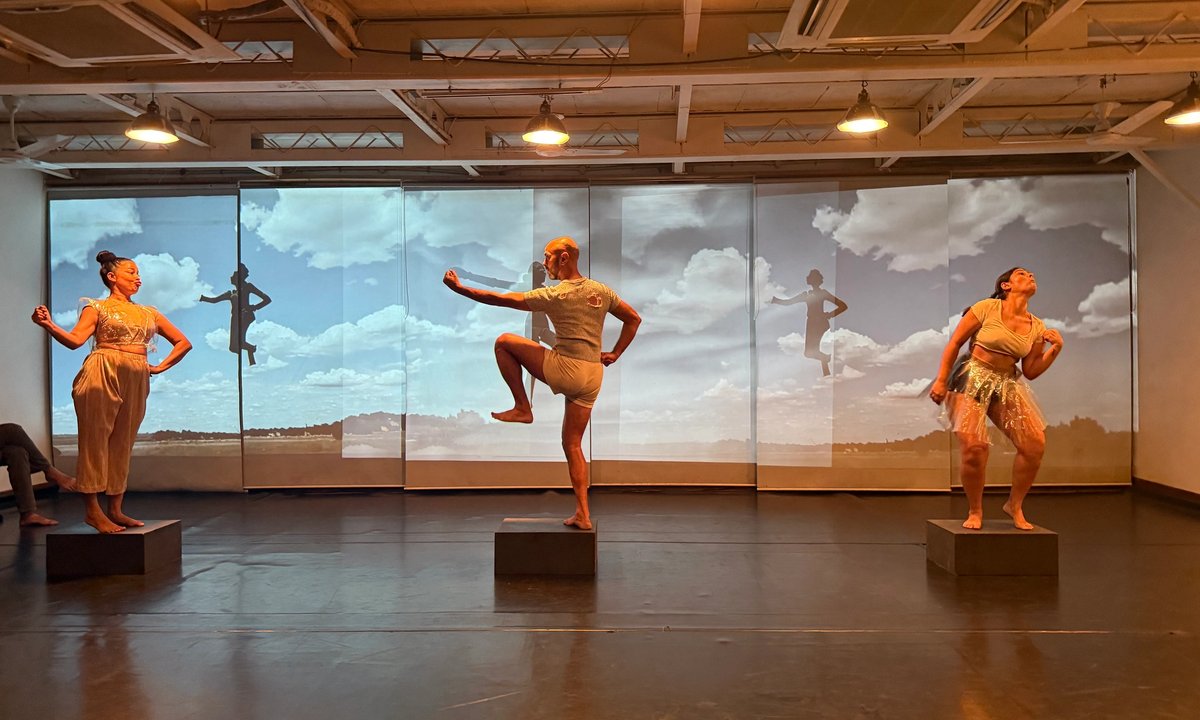Hallucinations of an Artifact performed at Khuli Khirkee, New Delhi on 28 November 2024
Courtesy of Vivek Gupta
As the status of heritage continues to bear heavily on India's vexed national identities, one of its leading contemporary choreographers, Mandeep Raikhy, responds with the new work, Hallucinations of an Artifact, which is currently touring across India and travels to Kolkata this week (17-18 December).
Raikhy's performance questions the agency of the bronze figurine Dancing Girl (around 2300 BC-1700 BC) excavated in 1926 in Mohenjo Daro, modern-day Pakistan, and currently housed in the National Museum, New Delhi. Archaeologists initially deposited the statuette along with other finds from the region in the Lahore Museum, but in the process of the subcontinent’s 1947 partition, Pakistan requested and received the steatite sculpture dubbed the Priest King and India was allocated the Dancing Girl.
Made with the lost wax casting technique, the object at the centre of Raikhy’s work is displayed in the museum on a miniature plinth in a poorly lit vitrine along with other archaeological finds dislocated from Mohenjo Daro. Standing just 10.5cm high, she greets her viewer with a confident gaze, bangles on her arms and wrists, and her bare body exposed, likely to signify her fertility. This stands in stark contrast to the 5ft-tall clothed and coloured mascot iteration which welcomed visitors to the International Museum Expo held last year in New Delhi. Here she was labelled “mother”, heightening her nationalist undertones.
We will likely never know the figurine’s precise function within the prehistoric context from which she emerges—historians have contended her stance is one of a warrior, not a dancer, for example—nor the many worlds she has traversed since. This ambiguity allows Raikhy and his two colleagues, Akanksha Kumari and Manju Sharma, to speculate with their bodies who this national icon is and was, and the work she has performed for societies spanning millennia. In their performance, the dancers sometimes impersonate the figurine as she looks today, by boldly widening their gaze. At other moments they give life to the possible society from which she emerged with natural, yet brutal human sounds.
Dancing Girl (around 2300 BC-1700 BC)
Courtesy of National Museum, New Delhi
In development since 2019, Hallucinations of an Artifact began as a meditation on the tribhanga pose in Indian dance and iconography—when the body is in an S-shaped twist to draw attention to both the breasts and hips at the same time by a bend in the knees. While it seems improbable that the lanky and rigid body of the girl statuette, her arm bended to her side, strikes this pose, it nevertheless is a myth in wide circulation. And both the robotic movements of the dancers and the space-age digital soundscape at times respond to this lore.
To represent the tribhanga prefix, the work is performed by three dancers in simultaneous movement. The use of the trio—ie the minimum multiple, not a binary nor singular—enables for the dancers to stage multiple relations at once and play on the uncertainty inherent in the figurine. This effectively allows for struggles felt and enacted by the performers not to come across as a combat between only two options, but for there to be a third, akin to the figure of the sakhi (girlfriend) in Indic poetics.
Unfolding in just under an hour in seven interlocking parts, the performers inhabit three plinths and three walls with a background video projection by Raikhy’s collaborator Jonathan O’Hear. Initially a technical requirement to accommodate projectors, the plinths became central to the work as they enable the dancers to evoke the object’s dislocated display in a museum context. The projection harnesses AI to speculate on the sculpture’s many lives from its origins in the Indus Valley to sterile contemporary display. O’Hear brings Dancing Girl to the city, to the nightclub, suspended in fields and lakes, and splices her body with other national symbols. These images provoke us to reimagine the worlds this object has borne witness and its aliveness that is so often taken for granted. At times, the dancers are in clear dialogue with the projection, and our gaze drifts to the background while they pause their movement. At other times there is a dissonance between the moving images and bodies, muddling the projection’s purpose.
Sweating, writhing, and howling, the dancers enact primal gestures that a museum display, and indeed a nation, can so often seek to tame in its objects. The soundscape, gestures, and movements toggle between evoking the deep past from which the figurine emerges and a dystopic future conjured by modern Indian politics. Violent animalistic noises, fights, and competitions can cause the discomfort that the nation seeks to neutralise through the discourse of sanitation and control. One performer begins to retch, and slowly another does, until they are all suffocating from the air. Like spinning tops, one of the performers becomes agitated, then another, and then all of them together, until they twirl out of control.
With the Kochi-Muziris Biennale having announced its 2025-2026 curator as the performance artist Nikhil Chopra, the potential of the ephemeral body is a pertinent subject. Certainly the medium has proven effective within Raikhy's oeuvre as a means to tackle fraught political issues, whether it be the article that criminalised homosexuality in India until 2018 that he addressed in Queen-Size (2016), or the Citizenship Amendment Act passed in 2019—which targeted Muslims—that he took up in The Secular Project (2020).
The ephemeral and deeply personal medium of movement makes the case for how these sweeping inhumane regulations play out in the realm of the human body. Raikhy skips over the plinth, affirming that these national objects are not meant to be contained, but they are living and suffering, in full anticipation of dystopian futures.
• Hallucinations of an Artifact, The Urban Theatre Project, Kolkata (17-18 December)

